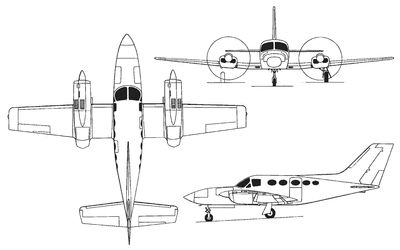Seven Members Of A Florida Family Fatally Injured When The Cessna 421 Went Down
The NTSB has released its probable cause report in an accident which resulted in seven members of a Florida family returning from a family reunion in St. Louis, MO. While the board said that the loss of an engine on the Cessna 421 contributed to the accident, it was the pilot's inability to control the airplane on a single engine that was the probable cause.

NTSB Identification: ERA11FA391
14 CFR Part 91: General Aviation
Accident occurred Saturday, July 09, 2011 in Demopolis, AL
Probable Cause Approval Date: 01/15/2013
Aircraft: CESSNA 421C, registration: N692TT
Injuries: 7 Fatal.
NTSB investigators either traveled in support of this investigation or conducted a significant amount of investigative work without any travel, and used data obtained from various sources to prepare this aircraft accident report.
The multi-engine airplane was in cruise flight at flight level 210 when the pilot declared an emergency due to a rough-running right engine and diverted to a non-towered airport about 10 miles from the airplane’s position. About 4 minutes later, the pilot reported that he had shut down the right engine. The pilot orbited around the diversion airport during the descent and reported to an air traffic controller that he did not believe he would require any assistance after landing. The airplane initially approached the airport while descending through about 17,000 feet mean sea level (msl) and circled above the airport before entering a left traffic pattern approach for runway 22. About 7,000 feet msl, the airplane was about 2.5 miles northeast of the airport. The airplane descended through 2,300 feet msl when it was abeam the runway threshold on the downwind leg of the traffic pattern. According to the airplane information manual, procedures for landing with an inoperative engine call for
“excessive altitude;” however, the airplane's last radar return showed the airplane at an altitude of 700 feet msl (about 600 feet above ground level) and about 3 miles from the approach end of the runway.

The airplane was configured for a single-engine landing and was likely on or turning to the final approach course when it rolled and impacted trees. The airplane came to rest in a wooded area about 0.8 miles north of the runway threshold, inverted, in a flat attitude with no longitudinal deformation. A majority of the airplane, including the cockpit, main cabin, and left wing, were consumed by a postcrash fire. Search operations located the airplane about 6 hours after its expected arrival time. Due to the severity of the postcrash fire, occupant survivability after the impact could not be determined. Examination of the airframe, the left engine, and both propellers did not reveal any preaccident mechanical malfunctions or failures that would have precluded normal operation. The investigation revealed that the right engine failed when the camshaft stopped rotating after the camshaft gear experienced a fatigue fracture on one of its gear teeth. The remaining gear teeth were fractured in overstress
and/or were crushed due to interference contact with the crankshaft gear. Spalling observed on an intact gear tooth suggested abnormal loading of the camshaft gear; however, the origin of the abnormal loading could not be determined.
The National Transportation Safety Board determines the probable cause(s) of this accident to be:
The pilot's failure to maintain airplane control during a single-engine approach and his failure to fly an appropriate traffic pattern for a single-engine landing. Contributing to the accident was a total loss of engine power on the right engine due to a fatigue failure of the right engine cam gear.
 ANN's Daily Aero-Linx (04.15.24)
ANN's Daily Aero-Linx (04.15.24) Classic Aero-TV: 'No Other Options' -- The Israeli Air Force's Danny Shapira
Classic Aero-TV: 'No Other Options' -- The Israeli Air Force's Danny Shapira Aero-News: Quote of the Day (04.15.24)
Aero-News: Quote of the Day (04.15.24) Airborne 04.16.24: RV Update, Affordable Flying Expo, Diamond Lil
Airborne 04.16.24: RV Update, Affordable Flying Expo, Diamond Lil ANN's Daily Aero-Term (04.16.24): Chart Supplement US
ANN's Daily Aero-Term (04.16.24): Chart Supplement US




